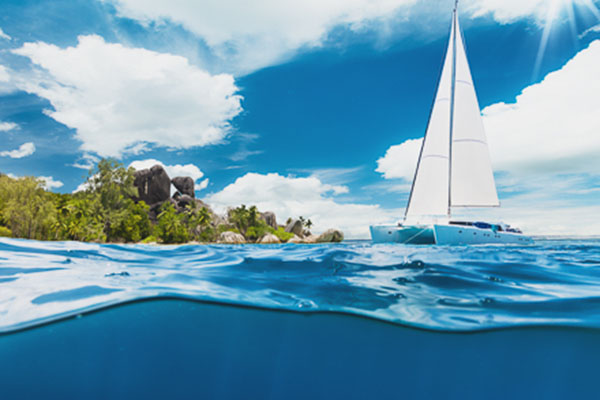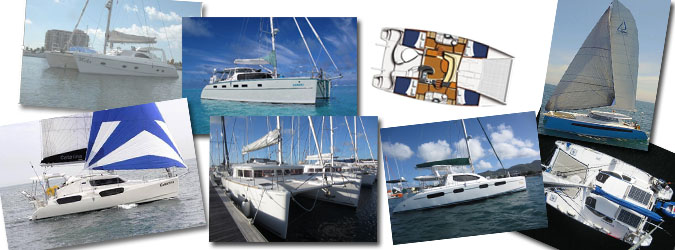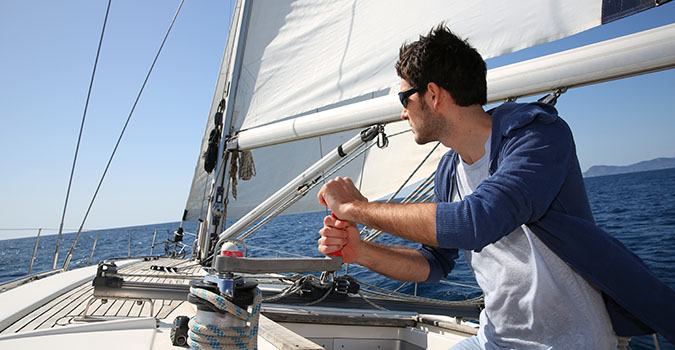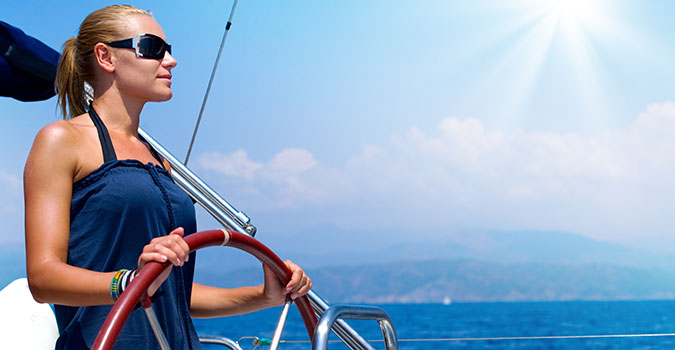Story by Phillip Berman / June 20, 2017


Are you the sort of guy who asks builders for performance Polars? Who measures a catamarans power to weight ratio? Do you spend hours poring over catamaran owner web blogs and or forums? Do you research carefully the difference between various foam cores, glass materials, resins? Are you attracted to electric engines and lithium Ion batteries? Intrigued by rotating wing masts, foils, or curved dagger-boards? If you answer yes to most of the above you are what we yacht brokers jokingly call a “spreadsheet guy.”
As a life-time sailor and racer I honestly much prefer working with spread-sheeters over impulse buyers. Spread-sheet guys wisely focus on both the visible and the invisible when buying a boat because they recognize the purchase of a large catamaran is not, as one of my customers smartly says, “like buying a stick of bubble gum.” It is a big purchasing decision and all due diligence is in order.
There are, however, several limitations to the spreadsheet approach because the spreadsheet has a difficult time capturing the larger picture of what ultimately ads up to a great catamaran, or the many trade-offs a designer must make when designing a yacht. Here are 14 things spreadsheet guys too often forget when crunching their numbers:
Spread sheet guys know that they need accurate information to punch into their computers. Sadly for them, however, the light ship weight advertised by builders is the approximate weight of the boat before they add on a single option, the tender, the spares, etc. In all my years of yacht brokering I’ve never weighed a production catamaran that came in anything close to lightship weight. The older design Catana 471, for example, was said to weigh 26,000 lbs. One of our customers weighed his last year and it came in over 33,000 lbs. Just yesterday, during a survey in Greece, we hauled out a Catana 582 with an advertised weight of 23 tons. The crane operator scaled her in at 28 tons.
A few years ago a gentleman hired me to serve as his buyer broker and became infatuated with a Sunreef 70. I explained to him that such a boat was ideal for charter, a true palace of luxury inside, but he had best not be hoping for high performance. He begged to differ because he had gone to some website that calculates catamaran performance based on advertised numbers and was told it would consistently sail at 12 knots. Having sailed one of these yachts in a sea trial it was abundantly clear to me he picked up some very bad information.
About a year ago a man emailed me and asked if we had Polars for the new Balance 451 I had co-designed with Roger Hill. “No” I replied. “Why do you want them?” I never should have asked. Spreadsheet guy! I emailed Roger Hill and asked him to work with a firm in New Zealand to do the polars. When they arrived it became clear that if our Balance 451 could sail to the numbers that were generated we should have contacted Elon Musk to join his rocket team. All of the numbers punched in were as accurate as we could get, for the lightship boat. The polars said that in 30 knots of wind on the beam we would be sailing at 26 Knots. Give me a break! I might be running to the bathroom in those conditions at this speed (what our friend Jeff Jones jokingly calls “diaper weather”), but I immediately decided these numbers were useless. I’ve sailed the boat enough to know that she likes to sail happily in the 9 to 10 knot range with cruising gear and is happy in the right conditions to sail in the mid-teens. That’s quite fast enough for me. But if only the numbers are to be trusted I’ll just let you spreadsheet guys go ahead and deceive yourself. The Balance 451 is a 26 knot cat! Works fine for me. But it ain’t so.
The most relevant question for a voyaging sailor is what sorts of speeds his boat will average over a 24 hour period in winds over 10 knots on all points of sail when operated short-handed without pressing the boat.
One of the most exasperating things about boat shows is the performance nonsense tossed about by salesman on the docks. When folks are telling you that X charter cat can easily exceed 15 knots you must know this refers to a glorious mili-second in time captured on the GPS as the boat surfed down an 8 foot wave in 20 plus knot beam winds.
One good way to learn how easily a boat is driven is to motor her. If you run her up at 3,000 RPM, how fast will she go with her standard motors? Then back off and see how much her speed drops at 2,500 rpm? Then at 2,000 RPM? Every boat has a sweet spot where she slides through the water easily and efficiently and to go over that spot requires you must push her very, very hard to gain but a marginal increase in speed. The easily driven speed is the only thing that matters because when you are cruising you cannot safely push a boat for hours on end. Fact is, very few production catamarans today are capable of averaging over 7.5 knots over a 24 hour period.
Before a race everyone is taking everything off their boats and storing away sails they won’t be using, emptying the tanks, etc. We all know any boat will go faster the lighter we can make her. But if you are a cruising sailor you had best run your spreadsheets with all the stuff you intend to carry because it is one thing to go fast on an empty flat sided performance cat and quite another to sail fast when loaded for a voyage. Probably the most important number to factor into that spreadsheet is what is called the sinkage ratio. How many pounds does it take to sink an inch? Flat sided hulls will sink a lot faster than flared hulls. The top end speed of a flat sided hull empty is higher than the top end speed of a flared hull, or wider hull. But often enough, when you load them up, the flared or wider hull will start to outperform the narrower or flatter hull. It is for this reason that any good design process starts with a careful measurement of both what a boat will weigh with the chosen materials, but also what she will weigh after the consumer puts on his dive compressor, tender, generator and air conditioning, etc. My own observation in this business is that a lot of spreadsheet guys talk a good game about “keeping it light” but often overload their boats with gusto. So if you are going to get yourself a skinny boat either keep her on a diet or find something designed to carry the true loads you will be voyaging with.

It doesn’t take a spreadsheet to know that a dagger boarded cat is going to sail consistently higher and make less leeway upwind over a cat with fixed keels. Anyone who says otherwise is selling cats with keels (which, by the way, are far cheaper to fabricate.) They will also tell you that dagger-boards are complicated to operate, etc, which is also not true.
What is harder to calculate is what sort of performance a boat will make sailing into a range of different seas and winds, regardless of her keel and or dagger-board configuration. This is because upwind speed is heavily influenced by the quality of the main and jib – whether they are radial cut or not mostly – but also primarily by two major competing design issues- underwing clearance and windage.
All things being equal a cat with low underwing clearance should be a lot lighter and have less windage than a cat with high underwing clearance. In smooth or modest seas a low clearance cat should therefore be faster upwind – again, all things being equal. As the seas build, however, and hydrodynamic drag increases on the underwing the higher clearance cat should start to perform better, despite the fact that she also has a higher level of windage and carries more fiberglass weight. A lot of spreadsheet guys forget this – they fail to see that sticking a cat up high off the water an extra foot or more ads to a lot more weight and a lot more windage. This is a design trade off that is often difficult to punch into the spreadsheet. If we were sailing in the same conditions all of the time it would be far easier to design the perfect catamaran.
Most spreadsheet guys are focused on performance. They often reference this brand or that, tossing out numbers, statistics, etc., and often enjoy lambasting heavy charter cats. They have an idea of what they think is the Ferrari or the Porsche of catamarans based on “the numbers” or the price or the pedigree of the designer. What many fail to understand is that it isn’t at all difficult to design and build a fast catamaran. It is not a great secret to achieve – make her long, lean, and light and give her plenty of sail.
No, what is difficult, and what spreadsheets cannot measure, is the far more important stuff – How does she sleep? How does she ventilate? How easily is she sailed? What are her sight lines like when sailing or sitting inside? How easy is she to dock and maneuver? How intelligently is she laid out? How well are her systems designed for care and maintenance and reliability? And on and on. A yacht design is a thousand little decisions and trade off’s that, if well done, achieve a desired objective. Before criticizing those heavy charter cats recognize they are getting a lot of things right on the living elements based on the feedback of hundreds of charterers.
As for the endless helm station debates, I give up! If you love dual helms, or forward cockpits, or bulkhead helm designs, or interior helms, or fly bridges, who am I to tell you you’re nuts! All helm designs have advantages and disadvantages.
I am always fascinated at boat shows when people go giddy talking about carbon this or carbon that, infusion over wet bag, carbon mast over aluminum mast. Too often, sadly, they are just dreaming about a catamaran they cannot afford. But if speed is all you’re after you can easily build, say, a 60 foot catamaran with far less costly materials that will clean the clock of a 50 footer made with exotic and very costly materials. I am very sure that one can build a 65 foot long cat with balsa core, marine plywood bulkheads, and use polyester resin (the cheapest materials on the block) and plaster a cat that is 55 feet long made in all carbon. That 65 foot cat will cost a lot less and sail a lot faster. It will, however, be a lot more costly to dock! This is not an argument for using balsa core or polyester resin – there are many good reasons not to use both materials – but it is an argument for measuring the value of the exotic over the less than exotic when deciding where you get the most performance “cluck for your buck.” That said, if price is no object, we all know the sky’s the limit.
In the end the purchase of a yacht is a deeply personal decision and I am of the view that there is no wrong choice on some level – I’d rather see people sailing on anything than not sailing at all. Some boats are obviously just a lot more desirable for specific objectives. I suppose a boat is worth what anyone is prepared to pay for it, but the spreadsheet has a difficult time measuring value. Just a week or so ago I was in St. Martin on business and a met with the skipper of an ultra-high performance cat, all carbon rocket ship. I asked him about the boat, her speed, and what she ultimately cost her owner to build. The sum he quoted me was staggeringly high.
At a recent boat show I attended there was a cat on display that was ten feet longer than the one we had on display at over 3 times the price. Yes, one could have bought three of our cats for the price of one just 10 feet longer. Again, if price is no object, why not. But the spreadsheet has a very hard time assisting buyers in making a value decision. I note that this is also the case with boat competitions. The judges of competitions are focusing on features they like, or materials they like, never it seems on whether a boat is a good value or not. I have no idea why.
As eluded to above, you can spend significant sums of money for marginal weight reduction. But of course it all adds up. If you can shave 1,500 lbs from a yacht using exotic materials that either means you can design her hulls a bit narrower or stick on that generator and big tender and air conditioning you cannot live without. I call these sorts of materials light expensive.
Examples of light expensive are all carbon hulls, carbon rigs, curved carbon dagger-boards, high end carbon sails, carbon stanchions, composite rigging, epoxy spray finished hulls, etc. All of the above are very costly materials that lead to a lighter faster boat for a much higher cost.
At the same time you can lower the weight of a boat in a wide range of ways by using cheaper less durable and or more maintenance intensive materials. I call this light inexpensive.
Examples of light inexpensive are using aluminum posts over stainless or carbon, plastic windows over glass or quality plexi, thin fiberglass tables and helm seats, less and cheaper cabinetry, canvas bimini’s over hardtops, zip up helm covers over sliding glass tops, dacron sails over radial cut sails in more quality fabrics, etc. If you are only measuring weight and not quality, speed over anything else, there are many ways to make spreadsheet guys happier for less money up front at the expense of a less live-able, less durable and more costly boat to maintain over time. Just because a boat is lighter than another, or appears to be so, does not mean it is better quality. Nor is that so, of course, for a heavier boat.
One common error made by spreadsheet guys is when they compare cats of the same length without comparing the actual volume of the fiberglass parts. One cat might appear on paper to be heavier for the same length, but that in no way means it is a heavier built cat – that the builder did not focus on weight or was just too unskilled to know how to build it light. Does the 50 foot boat have wider hulls? More deck storage? Does it carry more fiberglass volume aft or forward? These sorts of things are about the trade-offs in design made by the designer and builder. So if you are only going to compare weight then you are very likely not comparing live-ability, or payload capacity, or deck space, etc., etc. It is wiser to look at the materials and fabrication techniques a builder is using when comparing the volume of fiberglass parts.
Reducing laminate schedules can remove a great deal of weight from any boat, regardless of the hull core or glass chosen. At issue is where the line crosses with durability and safety after years of use. Over the years in my used yacht sales I have seen the deterioration and cost associated with builders that opt for on-the-edge laminate schedules to produce lighter fiberglass parts at the expense of durability. I see this in spider cracks, osmosis, delaminations, cracked bulkheads. These are very often the result of flimsy, right on the edge engineering. I therefore suggest spreadsheet guys jump up and down on the deck of the cat of their dreams and open up the hatches to see how and if they flex. Not all fiberglass parts are made the same. Not all yachts will be able to press safely against rough seas or stand the test of many years of use.
All the numbers may add up, but someone has to sail the boat, reef the boat, jibe, tack, and dock her, etc. Seamanship is earned not purchased and can only be measured by miles of safe voyaging. A great many spreadsheet guys purchase ultra-performance cats they are honestly unqualified to sail safely. Just a few days ago I was notified that someone capsized a Gunboat. My own recommendation to those who want to sail on a performance cat is to get themselves a beach cat to play on with a crazy power to weight ratio and learn what it means to be a “wind bender.” And to learn to sail without reliance on wind-speed meters or wind angle instruments. To really sail well one must learn to do it without instruments. Set aside the tech from time to time and feel the wind, watch the telltales, and bond with your boat and the seas and the wind. Allow your intuitive faculties to teach you deeper truths than your electronics.

A lot of spreadsheet guys are all about the speed, but forget too often they have a lover to please, who is actually and quite often a lot more intelligent than he is about choosing beds you can sleep in, kitchens that function, and living spaces that lend themselves to a higher quality of life experience – both at the dock and underway.
At the risk of sounding sexist, I meet very few women spreadsheet buyers, although I have come across a few from time to time. My own wife loves the birding term to describe what most women do so well, which is to nidify, to build a nest. When a woman walks onto a boat she is asking herself if she can turn this space into a home, for herself and those she loves. She is usually the one who puts up the art, picks out the pillows, and brings a measure of style and joy to the living space. That, in part, is why the charter boat builders are so very often successful making sales at boat shows – a lot of guys start out with spreadsheets and performance in mind but end up capitulating to be sure his wife is happy with the spaces.
Here is where the spreadsheet guy has the important challenge of explaining to his wife or lover that this boat sitting at the dock also has to move the family safely and comfortably from here to there. He must somehow explain that the more spacious and comfortable a catamaran is at anchor or the dock the slower and less comfortable she will be underway. And what is the point of buying a sailing a boat if it won’t sail?
In the end, those spreadsheets can tell us a lot, they can be very helpful. Just remember that in yachting everything is a compromise, there is no perfect boat, and the best you can do is seek to find the boat that best suits your needs and agenda in a price point you can afford. Whether you are sitting on a carbon fiber rocket ship in the Tobago Cays sipping gin and tonics with Richard Branson, or hanging about on a well-worn charter cat, the fish are the same, the bars are the same and the sunsets are the same. That spreadsheet may be fun to mess with, but it cannot make you happy. The conditions for the later are a brew of ingredients unique to you that only you can mix.
I suggest we set those spreadsheets aside and just go for a sail.
Phil Berman is a former Hobie Cat World Champion and the founder of The Multihull Company, a global catamaran yacht brokerage firm. He is also the owner of Balance Catamarans, a boutique brand of high-end performance voyaging catamarans. He can be reached at ph**@**************ny.com.
Awesome company that worked as my brokerage on purchasing out FP catamaran. A special shoutout to Will Miller for walking us through the process
The process of selling our boat was made very smooth by the Multihull Company and Andrew Hodgdon in particular. Andrew helped us navigate the selling process including moving our boat from Grenada to Florida to execute the sale. We would recommend working with this company, and Andrew Hodgdon in particular, without hesitation.
Very smooth process. Chuck was great and very knowledgeable about the whole process. Im happy to have had TMC to take care of all the things i didnt know about.
Andy
We feel like we got tremendous service from Chuck. He is a total professional, knowledgeable, confident and a natural salesman. While I’m really sad to give up the boat, we are compl we are completely satisfied that Chuck sold it for us.
The Multihull Company-St Augustine, and in particular Andrew Hodgdon handled the sale of my Balance 442 Catamaran. Andrew was professional, transparent and a pleasure to do business with.
Successful relationships cannot exist without it. At The Multihull Company we base every relationship on a firm commitment to earning and retaining our client’s trust.
Advice of any kind is valuable only when grounded in hard-won expertise. It too, must be trustworthy. Trust and expertise define the heart and soul of The Multihull Company. We are a team of skilled professionals who thrive on providing expert, trustworthy advice and service to catamaran and trimaran sailors around the globe.
Read More